
How to select the best Standard Operating Procedure (SOP) software

Finding the right SOP software for a company is hard. Some tools are too narrow in their scope to change your ways of working. Others risk becoming isolated islands in your existing application landscape. This guide covers the top 5 criteria for selecting SOP software that can turn your SOPs into real work practice.
The purpose of the guide is to give you a high level intro to SOP software selection by helping you to realize what matters to you. With this guide as a background you can go into a search to create a long list of software to look closer at. Software vendor listings are not in this guide. This is what I have decided to include:
What is SOP software?
SOP (Standard Operating Procedure) software is a tool for creating, managing, and documenting standardized procedures* within a company. It serves to ensure consistent, compliant, and quality-driven processes across various departments.
SOP software plays a crucial role in streamlining operations, enhancing employee training, and ensuring regulatory compliance. It fits within a company by providing a central repository for standard procedures, enabling easy access, revision control, and auditing. Standard operating procedure software therefore helps organizations maintain efficiency, consistency, and safety in their day-to-day operations while adhering to industry regulations and best practices.
New to ‘standard work’? Learn how standard work reduces complexity ↗️.
Examples of SOP software use
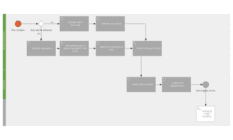
Fire Emergency Procedure
Process outcome: How to behave in case of a fire emergency in the workplace.
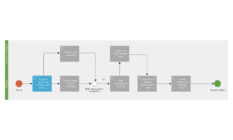
Hold Annual Performance Appraisal
Process outcome: Performance and development review completed and documented.
Is it any different from work instruction software?
While both SOP software and Work Instruction software deal with documenting procedures and instructions, they serve different purposes and cater to distinct needs within an organization. SOP software focuses on broader procedures, while Work Instruction software is more specific and task-oriented.
How is it different from BPM software?
Now that we have the differences between sop and work instruction software clear then you may wonder about the difference to Business Process Management (BPM) software? These are the key differences
- Granularity: SOP software deals with specific, detailed instructions for tasks that a single person does, while BPM software addresses high-level processes that involve multiple steps, employee roles, departments, and systems.
- Automation: BPM software often includes workflow automation capabilities to streamline and enforce processes, whereas SOP software primarily focuses on documentation.
- Scope of Control: SOP software is typically managed by the teams responsible for specific procedures, whereas BPM software may involve cross-functional collaboration and governance.
- Complexity: BPM software is more suitable for managing complex, interdepartmental processes, while SOP software is designed for simpler, task-specific procedures.
In summary, while both SOP and BPM software contribute to process management, they serve different purposes and have varying levels of scope and complexity. SOP software is tailored for creating and managing detailed work instructions, while BPM software is geared toward optimizing and automating broader business processes.
👉 Recommendation: Get your business processes mapped and under proper governance before you buy any SOP software. Why? This ensures a stable foundation and ownership so you minimize overlapping efforts.
As one of the fathers of modern manufacturing once put it:
”If you can’t describe what you are doing as a process, then you don’t know what you are doing.”
W. Edwards Deming

Now that I hope you have a better idea of how SOP software fits then lets take a look at its benefits. Hopefully the following list can help you built the case internally.
What are the benefits from using SOP software?
Implementing SOP (Standard Operating Procedure) software in a business offers several significant benefits, leading to results that can positively impact risk, compliance, and overall efficiency. Here are some of the key business benefits and the corresponding results that you can expect from succesful use:
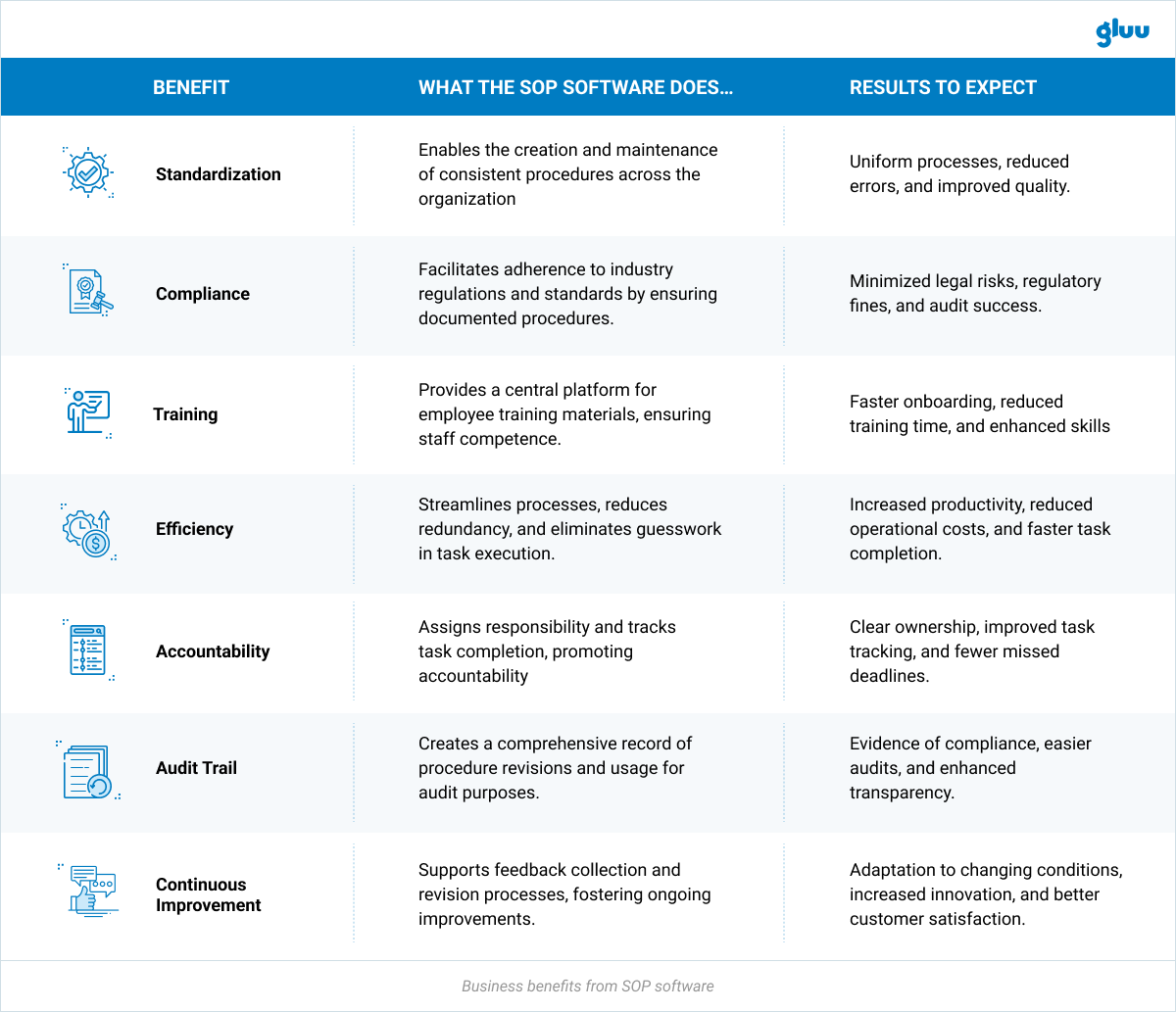
In summary, SOP software helps businesses achieve these tangible results by fostering consistency, efficiency, compliance, and continuous improvement. It not only enhances day-to-day operations but also strengthens the organization’s competitive position and ability to adapt to changing market conditions.
The question is how you select software that fits your business so well that it delivers such value to you. That’s the topic in the next section.
What to look for in a SOP software
Are you looking for SOP software that is specific to manufacturing, construction or pharmaceuticals? Then there are highly specialized solutions with best practice content that adheres to your country’s and industry’s regulatory standards etc. These are beyond the scope of this guide. If you’re looking for more general solutions that can fit any industry, then take a look at these six key areas and their requirement ideas:
So, you should be looking for SOP software that…
#1 Covers the right gaps in explaining your ways of working
If we assume the goal is to achieve standard ways of working through the use of digital SOP software, then the scope must be to be able to answer the following questions for each procedure:
- WHAT must be done? – and what is the intended business outcome?
- WHY should it be done in a specific way? Starting with the ‘why’ matters to employees’ motivation for following the standard – and their ability to challenge this.
- WHO is responsible for each activity? As you may have noticed, involving more people brings us outside of the SOP software category and into the Business Process Management category.
- HOW is the work done? This is where we may enter into the work instruction software category.
So to summarize: If we’re looking for standard ways of working, then we need to cover both the what, the why, the who and the how for every work activity.
As we outlined early this guide it matters if you already have work instruction software or BPM software in use in your company that may already cover parts of this:
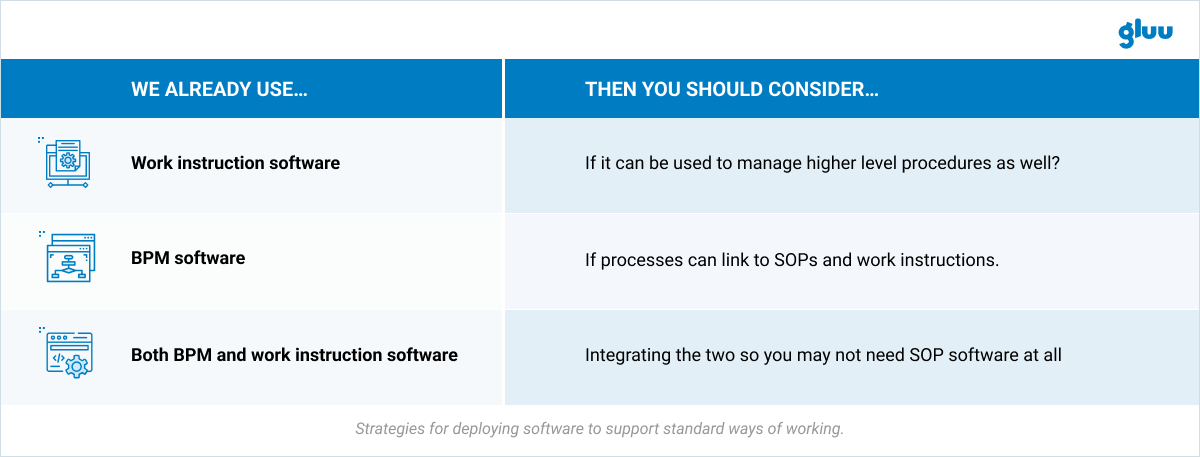
👉 Recommendation: Find out if you already use work instruction and/or BPM software and what it does and doesn’t cover – including through standard integrations.
Related requirements to include in your list:
- Integration Capabilities: The ability to integrate with other systems or platforms to link process documentation with other aspects of the business, such as training, quality control, or customer relationship management.
#2 Fits perfectly with your system landscape
Few digital SOP tools will get adopted by users if they don’t fit your culture and system landscape. In this table are some key considerations:
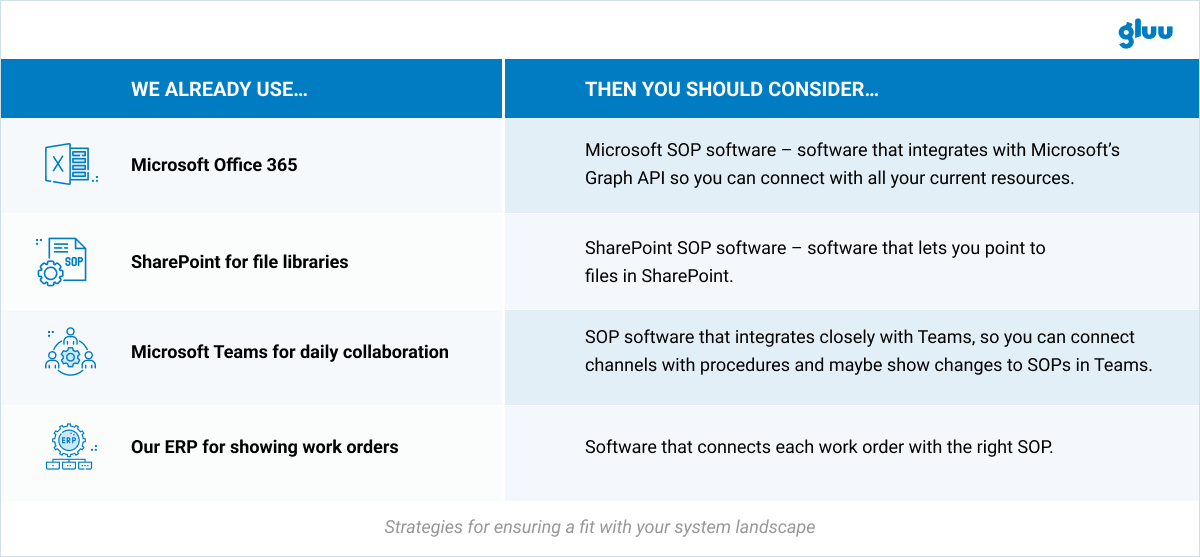
The examples above are for companies on a Microsoft tech stack. The same applies to companies on a Google tech stack, of course.
👉 Recommendation: Build your SOP software into your current tech stack so it doesn’t try to compete with employees’ daily tools.
Related requirements to include in your list:
- Microsoft Graph Integration: The ability to integrate with Microsoft’s Office 365 and Business Central products.
#3 Makes knowledge transfer more effective
Video SOP software is becoming a thing. This is because watching video is more effective than reading when it comes to retaining knowledge. The learning pyramid theory is based on research that shows that different knowledge transfer methods lead to different student retention rates:
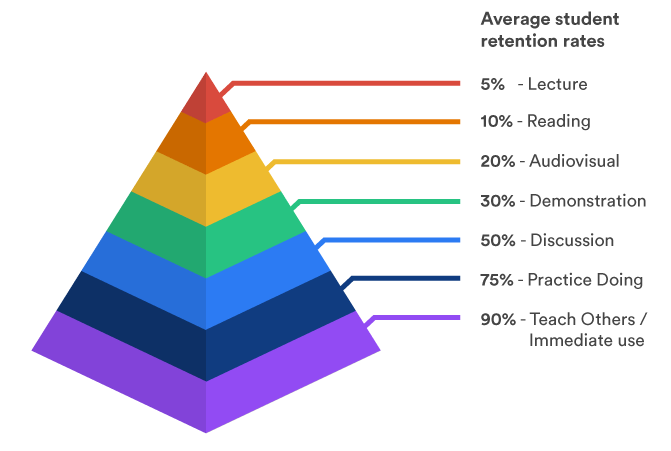
This also holds true when it comes to using Standard Operating Procedures to transfer knowledge about your company’s required ways of working. If you consider the learning pyramid, then ask yourself what matters in your company. E.g. can the future SOP software facilitate many tools for knowledge transfer?
Text and images combined?
Video and voice?
Online sharing sessions for demonstration?
Discussion and comments? (when the SOPs don’t make sense and need work)
Tasks to connect with real work practice?
👉 Recommendation: Go for SOP software that closes gaps in your current knowledge transfer tool set.
Related requirements to include in your list:
- Collaboration Tools: Features for multiple users to work on documents simultaneously, leave comments, and provide feedback.
- Visual Content Support: Capability to include images, diagrams, flowcharts, and videos to enhance the clarity of process explanations.
After all, what really matters is how knowledge is transferred so that our SOPs result in the behavior we’re looking to guide. Here’s an example of a Danish machine operator who explains how he uses the Gluu app:
#4 Personalizes information to the employee’s roles and skill levels
If you’re writing an SOP for Designers to do book keeping correctly, then it has to be supplemented with clear and detailed work instructions. The same goes for SOPs to Accountants to design in accordance with your SOP for applying your company’s brand. My point is that the audience’s roles and skill levels matter.
👉 Recommendation: Make sure that your future SOP software can include information about company roles and required skills and levels for working with each SOP.
Related requirements to include in your list:
- Search and Retrieval: A robust search function that enables users to quickly find and access specific documents or sections within documents.
- User Permissions: Granular control over who can view, edit, or approve documents to maintain security and compliance.
#5 Enables ongoing learning and changes
If you’re in a highly regulated industry, or in an industry that rarely changes, then I’m sure your SOPs don’t need many changes over time. However, if you’re in any other situation then you can count on regular changes being the norm.
Related requirements to include in your list:
- Version Control: Ensures that different versions of documents are tracked and can be easily compared or restored.
- Collaboration Tools: Features for multiple users to work on documents simultaneously, leave comments, and provide feedback.
- User Permissions: Granular control over who can view, edit, or approve documents to maintain security and compliance.
- Workflow Management: Tools for defining, automating, and tracking approval workflows for document changes.
- Analytics and Reporting: Provides insights into document usage, changes over time, and user engagement to support process optimization.
- Compliance Features: Ensures that documents align with industry regulations and standards, with options for audit trails and compliance reporting.
These features help companies document, communicate, and maintain their way of working effectively, ensuring consistency, compliance, and the ability to adapt to changing requirements.
Examples of SOP software features
Below are two examples of SOP software features from Gluu’s BPM platform. This designed to combine everything needed for standard ways of working, namely process modelling, SOPs, work instructions, roles, documents, task management and change communications.
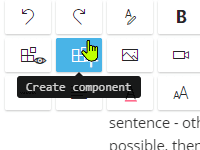
Reusable work instruction components
Turn selected content into components to be reused across processes, saving time and effort.

Embedded video and images
Upload or embed videos and images to support work instructions on both desktop and mobile.
We hope that this has inspired on how to focus your search for standard operating procedure software. What is left now is to get started. We’ll end this guide with a summary of the typical steps involved:
How to do a proper SOP software comparison
Here is a list of typical steps to do a proper evaluation to find the best SOP software vendors:
- Define Requirements: Start by listing your organization’s needs and objectives.
- Research Solutions: Compile a list of available SOP software solutions.
- Initial Screening: Eliminate options that don’t meet your basic needs.
- Request Information: Contact providers for demos and documentation.
- Evaluate Features: Compare document management, collaboration, compliance, and more.
- User Interface: Assess user-friendliness and intuitiveness.
- Integration & Scalability: Check for system integration and scalability.
- Compliance & Security: Ensure industry compliance and data security.
- Support & Training: Inquire about customer support and training.
- Cost Analysis: Calculate total ownership costs.
- User Feedback: Seek input from potential users.
- Vendor Reputation: Research the vendor’s track record.
- Demo & Trial: Request live demos or trials.
- Make a Decision: Rank solutions based on alignment with requirements.
- Pilot Implementation: Test the chosen solution on a smaller scale.
- Finalize Contracts: Negotiate and finalize the contract with the chosen vendor.
Conclusions
So to conclude this guide you should focus on the big picture ‘fit for purpose’ or ‘real world business fit’, rather than listing category specific details. These can wait until you’re sure that you are actually looking for SOP software, and not software to plug holes in your current setup, work instruction software or BPM software.
If you end up buying software from the wrong category, then it doesn’t matter if you’re buying the market leader. It may not lead to standardized ways of working in your company.
We hope you have found this guide useful! Now to help you take the next step here is an SOP template that you may want to use:
Free SOP software selection template
We’ve had an experienced procurement manager create a comprehensive selection guide in Word. It covers the best
practice areas of:
I Innovation & Design
M Management & Financial
P Performance & Operation
A Assurance & Continuity
C Cost
T Transparency & Ethics
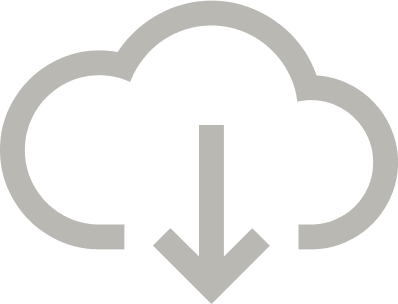
Frequently Asked Questions
SOP software manages standardized procedures within a company, ensuring consistency and compliance. It documents step-by-step instructions for processes in industries like healthcare, manufacturing, and quality control.
SOP software streamlines operations by providing standardized procedures, enhancing consistency, reducing errors, ensuring compliance with regulations, and improving employee training. It increases efficiency, quality, and safety, while also facilitating audits and adaptability to changing business needs.
SOP software focuses on documenting and managing standardized procedures for broad processes, ensuring consistency and compliance across an organization. In contrast, work instruction software is task-specific, offering detailed guidance for specific job tasks, often with visual aids, and is commonly used in manufacturing and maintenance for precise task execution.
1 Covers the right gaps in explaining your ways of working
2 Fits perfectly with your system landscape
3 Makes knowledge transfer more effective
4 Personalizes information to the employee’s roles and skill levels
5 Enables ongoing learning and changes



